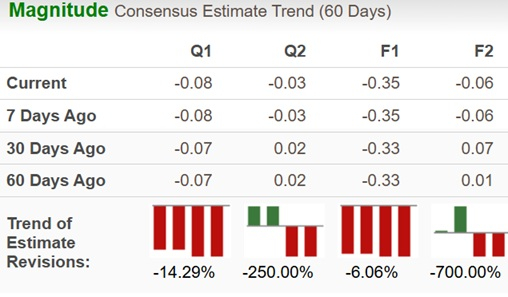Netflix’s Stock Soars But Faces Critical Challenges Ahead
Despite a robust rise of nearly 60% in Netflix’s (NASDAQ:NFLX) stock this year, the streaming giant contends with significant risks that could impact its growth trajectory. In contrast, Disney (NYSE:DIS) has seen a modest increase of just 5% during the same timeframe. While Netflix has made strides with its efforts to limit password sharing and broaden its ad-supported streaming options, the company still faces questions regarding its long-term viability. Could Netflix’s stock eventually drop to around $400 from its current price of approximately $750? Given the stock’s historical volatility, this speculation may not be far-fetched.
The Changing Landscape of Netflix’s Growth
Netflix has experienced remarkable revenue growth, expanding from about $20.16 billion in 2019 to approximately $33.7 billion in 2023—an annual growth rate of roughly 14%. Projections indicate a rise to nearly $39 billion by 2024. Nonetheless, growth may begin to slow, potentially dipping into the low or mid-single digits. The push for subscriber growth recently added over 50 million users, lifting the total to around 283 million. This surge included a crackdown on password sharing that compelled many to create their own accounts. However, with the policy implemented in over 100 countries, future growth opportunities might be limited, hinting that some subscribers could have been pulled from future growth years.
Recent numbers suggest this challenge is evident, as paid net additions in the U.S. and Canada dropped to 0.69 million in Q3, significantly down from 2.5 million in Q1 and approximately 1.5 million in Q2. Additionally, Netflix’s Average Revenue Per User (ARPU) may face challenges. The company has consistently raised prices—its most popular ad-free plan increased from $10 in 2017 to $15.50 today. Despite its ability to monetize users without significant churn, competitors like Disney offer compelling bundles that may lure subscribers away.
Though there is room for multiple subscriptions in the streaming market, a fierce competitive environment coupled with economic uncertainty hampers Netflix’s ability to implement further price hikes. Its cautious approach is evidenced by not raising the price on its standard full-HD plan since January 2022. These factors combined could lead to slower revenue growth, with estimates suggesting an average of just 5% over the next three years, resulting in about $45 billion in revenue by 2027.
Potential Shrinking Profit Margins
On the profitability front, Netflix’s net margin increased from 9% in 2019 to about 16% in 2023, with projections of 22% for this year. This growth is driven by a larger customer base and enhanced cost management. However, the landscape may shift with rising costs as Netflix invests more in live content, including NFL games and WWE programming. Such rights are expensive, and adjustments will be necessary to maintain profit margins amid these changes.
Additionally, Netflix has struggled with cash flow in prior years, accumulating just under $300 million in free cash flow from 2019 to 2022. The figure improved to over $6.9 billion in 2023, partially due to reduced spending during industry strikes, but content costs will likely rise again in 2024. Continuous pressure on these costs, alongside a slowdown in growth, could lead to net margins contracting to approximately 20%, translating into net profits of around $9 billion by 2027—only a modest increase from 2024 levels.
The Outlook for Investors
Currently trading at about $750 per share, Netflix’s valuation stands at around 37 times its forward earnings, raising concerns about its perceived expense. Although recent performance has been strong, market perception often tends to focus on short-term achievements. Investors may be overly optimistic about Netflix sustaining its subscriber growth and comfortably achieving double-digit revenue increases. As the momentum from password-sharing restrictions and ad-supported initiatives stabilizes, a slowdown is likely.
If Netflix’s price-to-earnings (P/E) ratio drops to about 20 by 2027, calculated earnings of $9 billion would result in a market cap of approximately $180 billion, translating to about $400 per share. This adjustment, while seemingly drastic, aligns with Netflix’s historical patterns of reacting sharply to market changes, as seen with a decline exceeding 70% from October 2021 through May 2022 after post-Covid adjustments.
As we project this potential downturn, the timeline remains somewhat flexible. Whether the changes occur within three or four years, a slowdown in subscriber growth and ARPU could indeed prompt a significant correction in Netflix’s stock value. For further insights, refer to our analysis on Netflix Valuation: Expensive or Cheap.
| Returns | Oct 2024 MTD [1] |
2024 YTD [1] |
2017-24 Total [2] |
| NFLX Return | 6% | 54% | 506% |
| S&P 500 Return | 1% | 22% | 159% |
| Trefis Reinforced Value Portfolio | 1% | 16% | 766% |
[1] Returns as of 10/29/2024
[2] Cumulative total returns since the end of 2016
Invest with TrefisMarket Beating Portfolios
See all Trefis Price Estimates
The views and opinions expressed herein are the views and opinions of the author and do not necessarily reflect those of Nasdaq, Inc.







